
Since the rise of the glass working craft in the early 20th century there have been many new types of glassware created. Is any of this older glassware now more valuable? If so what types of styles are the most popular or rare?
Colored glassware from the 1920s-1940s is referred to as depression glass. It is a low costing or often free glass that many used during the Great Depression due to its less labor-intensive molded and patterned design. Short-lived colors and patterns are now highly sought after and valuable.
There are many beautiful pieces of depression glass art hidden in thrift and antique stores. Here’s how to pick the treasures from the mundane.
Depression Glass
It is extremely collectible and sought after by many who know of it, but what is depression glass?
Depression glass was known as such due to its easily manufactured design and subsequent boom in the Great Depression. The molded, patterned glass was much cheaper to make thanks to innovative machinery that allowed companies to keep people employed during this time. Depression glass is always patterned, though not always fancifully colored. Depression glass can be clear or “crystal,” though not made from any crystal, and not colored in this sense, but still be categorized as depression glass.
Its designs were impressive but simple, and this glassware was so easy to make that almost anything that could be glass was made into glass. Pitchers, teacups, cake stands, bowls, plates, and large utensils are only some of the many types of glassware made from depression glass.
Over 100 types of patterns were manufactured while it was popular. Additionally, each company had signature molds or colors. These signatures were differing in price and value. Some company’s signature pieces were widely sold and highly common, while others were created in small batches and valued more, especially now. (Source)
Nearly all depression glass was produced in Ohio River Valley. There were many glass companies in this area, though not all of them were located in this area. A few of the most popular companies that made depression glass were Hazel Atlas Glass Company, Hocking Glass Company, Federal Glass Company, Indiana Glass Company, Macbeth-Evans Glass Company, Jeanette Glass Company, Imperial Glass Company, Lancaster Glass Company, U.S. Glass Company, and L.E. Glass Company. (Source)
Pattern
Now that we have discussed what depression glass is and where it comes from, let’s get into the rare patterns you will find on depression glass.
Royal Lace
Royal Lace is most often thought of as the most desired and rare pattern of depression glass. This pattern was created in pink, crystal, and green, but most interestingly it was made in cobalt blue. The blue glass was only produced for five years, making it the more rare type of the already valuable Royal Lace pattern. The pattern is a repeating series of roses and lace with counters and etchings of intricate floral designs. Its beautiful pattern and elegant colors make it one of, if not the, most valuable and desired style of depression glass out there.
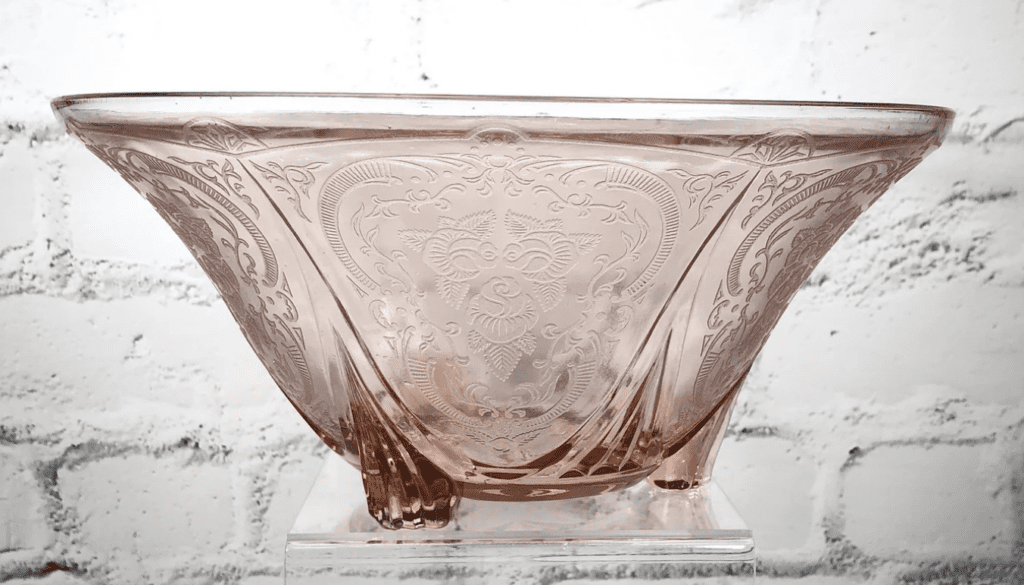
Cameo
This pattern was made by Anchor Hocking Glass Company. It is also known as “Ballerina” or “Dancing Girl,” and is often identified by its design of pearls stretching around each piece of glassware. It was created in many of the usual colors, and while many green pieces can still be found today for cheap, pink and yellow pieces can be quite expensive and rare. Some of the rarest cameo pieces were made clear, or crystal, with a platinum rim.
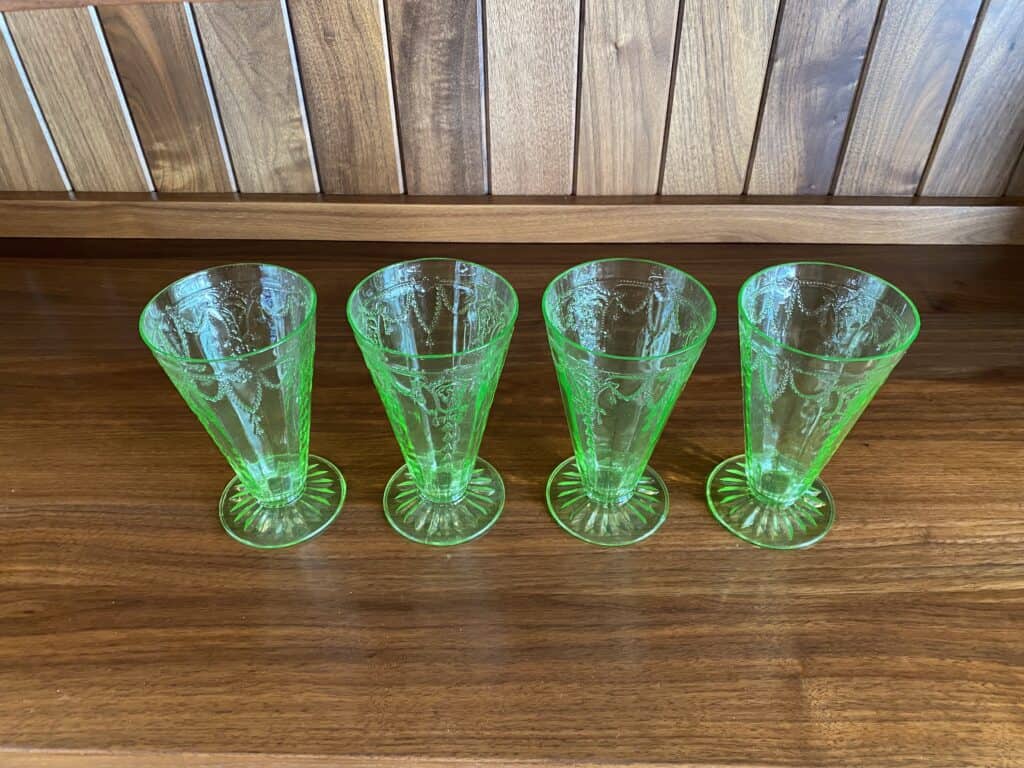
Mayfair
Often referred to as “Open Rose,” this pattern is found in pink and ice blue most often. It often has a square shape with softened and scalloped edges with diagonal cuts. Fostoria and Hocking both made these types of glass, with Hocking’s being more authentic to depression glass, as Fostoria fire-polished their Mayfair glassware, making it somewhat handmade and therefore closer to elegant glass than depression glass due to its care and perfections.
This pattern had different flowers in it, including sunflowers, and many shot glasses and cookie jars have been reproduced nowadays which can make collecting this rare design hard due to the availability of fakes.

American Sweetheart
Macbeth-Evans Glass was known for its American Sweetheart glassware. It was a thin and delicate pattern made mostly in pink. Its center was often decorated in delicate and intricate paisleys and curlicue patterns. It has an ethereal and angelic look that seems delicate but proves to be quite strong glass. It was a higher price than some other types of depression glass, which makes it even more expensive now. Its pricey pieces tend to be tumblers, pitchers, and soup bowls.
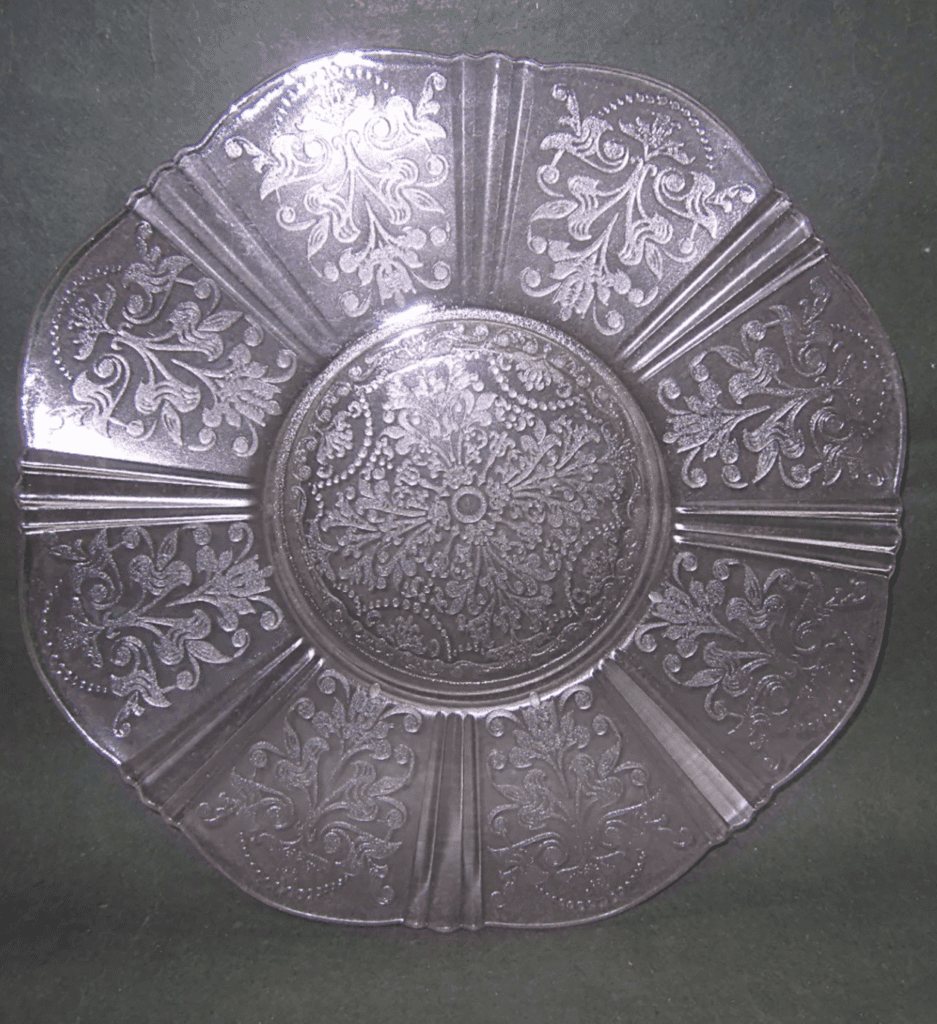
Princess
Princess depression glass is often square and made with scalloped edges with the corners cut off. It has wide rims and is recognizable by its patterns of tassels and scrolls. It often can be found with feathery designs made in the middle. It is highly sought after, and this pattern was coined by Anchor Hocking. It is often found in pink and green with the occasional yellow and light blue.
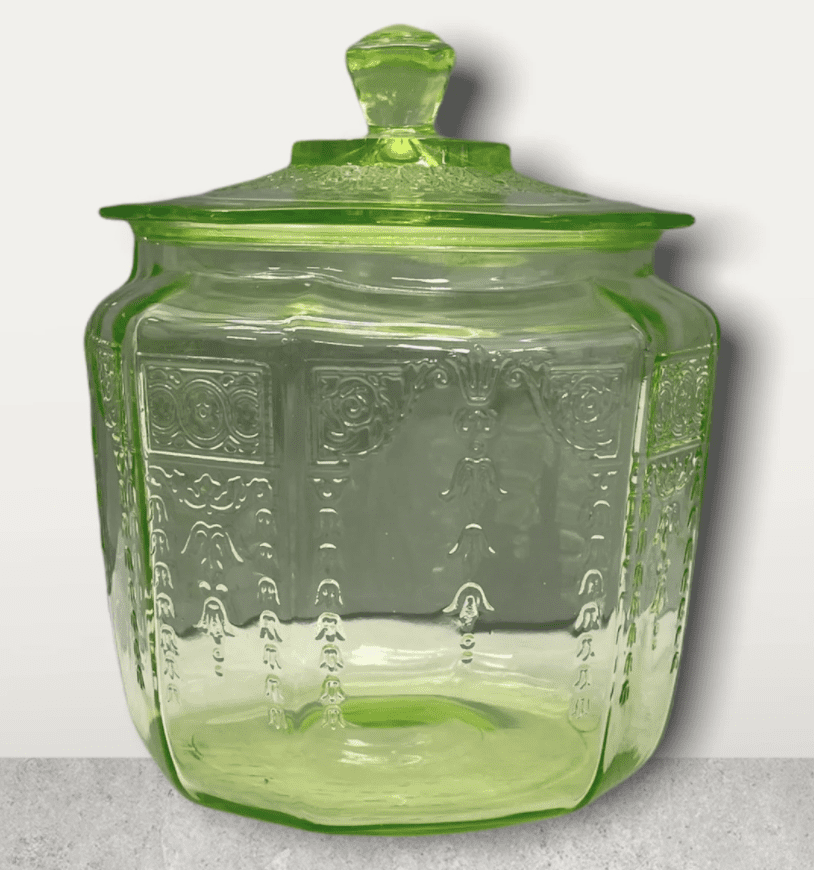
Cherry Blossom
This pattern is recognizable by its unique patterns of cherry blossoms in its glassware. It has been widely reproduced, so it is important to be able to recognize fakes when searching through these styles. It is most often found in pink and green but is known to have been made in pale blue and green as well.
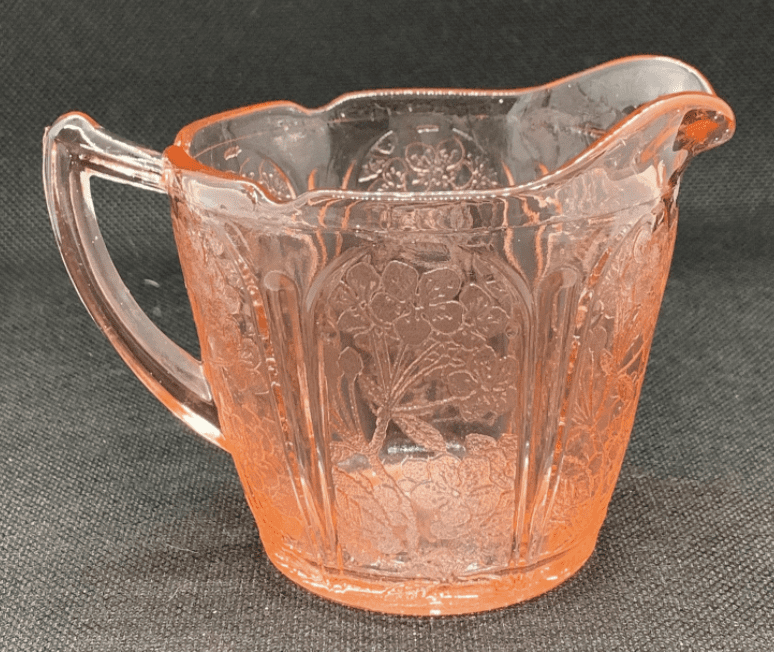
Doric
The pattern on Doric depression glass was made by the Jeannette Glass Company. It was similar to another of their designs named Pansy, which had a set of children’s dishes as well as the full set of regular dishes. This style has small repeating patterns of doily-like squares and is most often found in pink, green, and occasionally yellow.
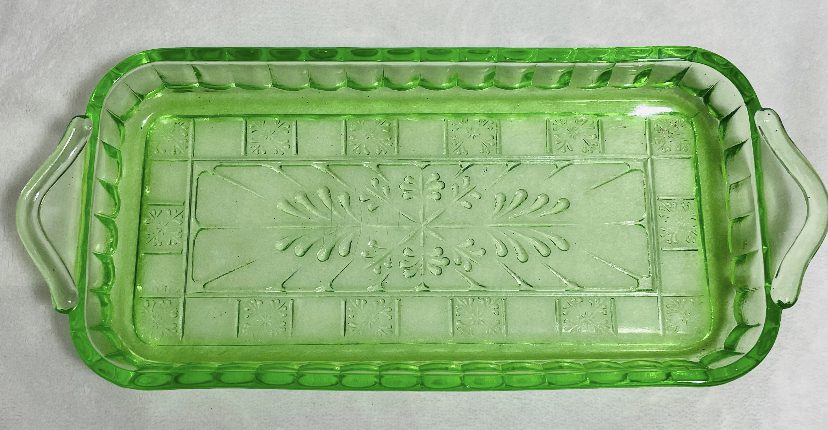
Aurora
This pattern is most often found in cobalt blue and is categorized by its vertical ribbed design. It is a very simple design compared to some of the other types of depression glass on this list, and as such is not as sought after as others such as Royal Lace.
However, it is still a beautiful style of glass that is very popular, but a little easier to find in thrift stores and antique shops. It is intended to be used for snacks or desserts and tends to be on the smaller side for dishes. It was commonly made by the Hazel Altlas Glass company in the late 1930s.
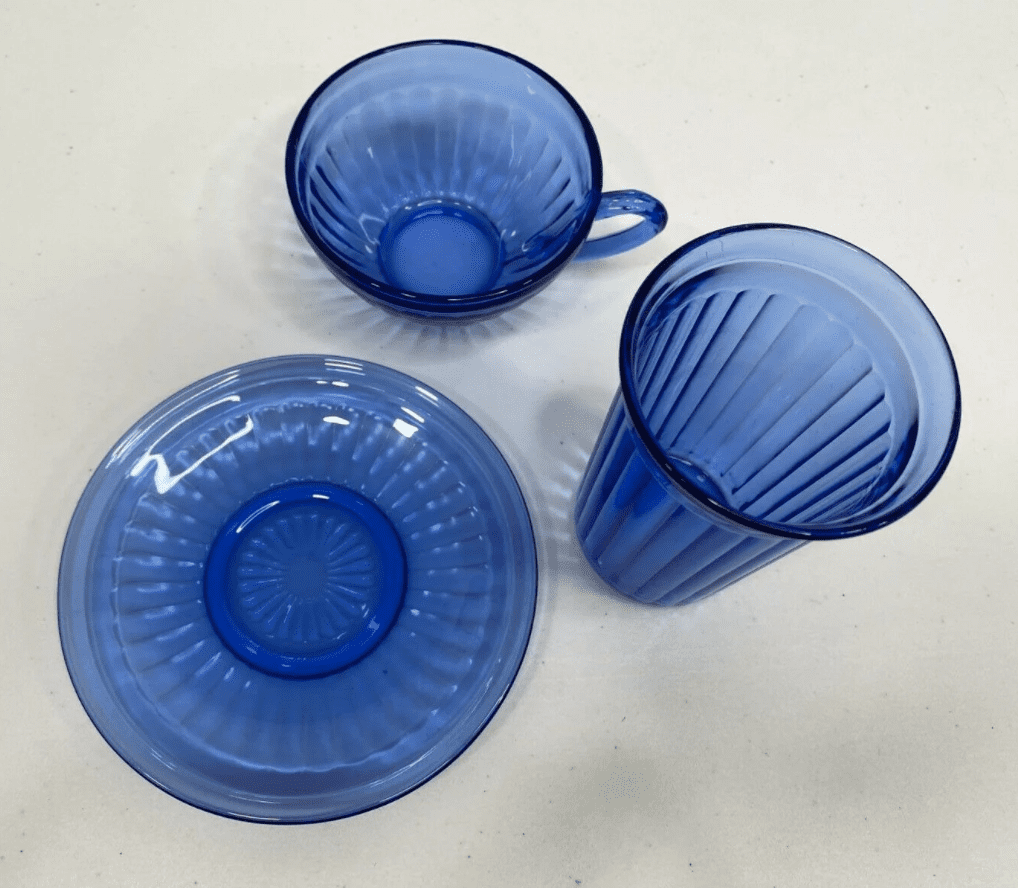
Imperfections
Depression glass with imperfections is not uncommon and often can help identify the genuine article. Bubbles, for example, are extremely common in depression glass but often will have been remedied in dupes. Real depression glass will have bubbles most commonly. This is the easiest way to determine whether or not that pitcher in the thrift store is genuine depression glass or a modern fake.
Other common imperfections are water rings, cracks, straw marks, inclusions, molding flaws, and color variations. These flaws are so common because of the fast manufactured way the glass was produced. While water rings, straw marks, and cracks can have been made during the pieces’ years of use, as this glassware would now be quite old, most imperfections would have been on the original as well.
Bubbles are to be expected in genuine depression glass. Inclusions are also not a rare sight in this glassware. Inclusions in the diamond and gem business mean small minerals or materials other than the pure stone that is found within the gem. This is the same with glassware. Inclusions are small patches of dirt or other materials that fell into the glass at some point during the manufacturing process and were enclosed into the glass.
Molding flaws were also common due to the way the glassware was made. Because of the fast way the molds were used, it was often that they might not impress enough into the glass and therefore cause variations in the final product. This was similar for color imperfections as well.
One imperfection made after the actual manufacture of the glassware is when the glassware has become sick glass. Sick glass is glass that has been clouded or scratched or etched by a dishwasher. These imperfections cannot be restored. It is impossible to clear the glass of this clouding after it has occurred.
Knowing these imperfections will help you identify if that piece of depression glass with a rare pattern on it is actually an antique.
Color
There are many different colors of depression glassware. Some think this was due to the desire for lifted spirits and wealth during the Great Depression. This is also why you will see that many of the patterns are called fancy, almost whimsical names. It is to mimic and inspire society’s desire to return to the prosperity and freedom of the 20s. (Source)
This being said, the most common colors on the market were lighter to medium shades of green, amber, pink, clear, and pale yellows. Almost all glassware could be found in these colors, and often still can be, for cheaper than some of their fancier colored counterparts. Some of those more opulent colors included deep red, pale blue, cobalt, ultramarine, milky white, translucent white, canary yellow, and opaque pale green or blue.
While not the most popular, the most interesting of these colors would be green. Most of the glassware made green at that time was done so through the use of uranium, which we now know to be a highly dangerous and radioactive element. These glassware products had such minute traces of the metal that they did not affect those who used or owned them, however, they did have the interesting quality of glowing under black lights. Sometimes they would even glow in the dark.
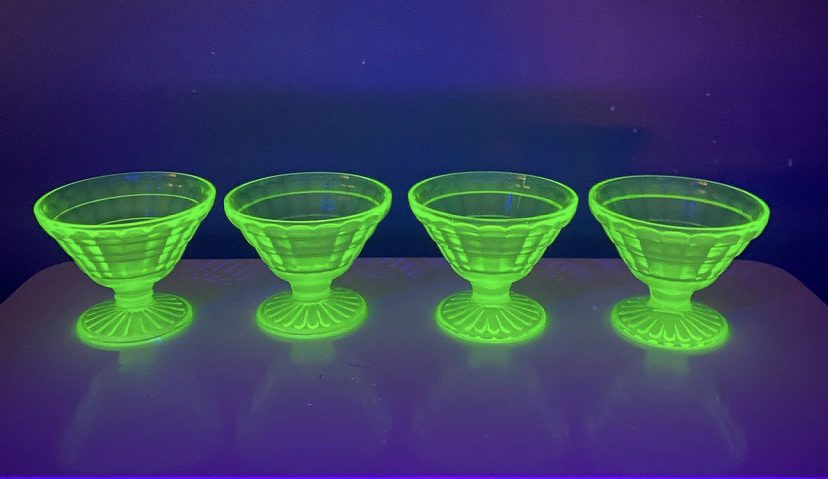
There are many pieces of depression glass that have been reproduced nowadays and are not the same value as rare authentic depression glass. It is important to be familiar with how to tell fakes from genuine pieces, but one way to tell is by looking at the color. Knowing what colors are more popular and which ones are rare can help hint at whether or not a piece of glassware is real.
There is plenty of colored glassware advertised as depression glass on the internet, however, they are often not genuine. It is a safe bet to avoid black-colored “depression glass” or black amethyst-colored dupes. Sticking to the common colors and carefully looking for imperfections in the glass can show which pieces are real depression glass and which ones are fakes.
The rarest colors of depression glass, such as tangerine and lavender, can be more expensive than even the coveted pink depression glass due to their rarity. Delphite (opaque blue), ultramarine, and jadeite (opaque green) were also rare colors but were still used enough to be well known.

Elegant Glass
Elegant glass is similar to depression glass, as it was made during the same era, but elegant glass was made to be more expensive than its cheap counterpart. Elegant glass was at least partially hand-made, often more vibrant, and had a clearer finish.
While most people were struggling financially at this time, there will always be some fortunate enough to be able to afford high-end products. This is for whom elegant glass was made. For the rest of the glass-making business, opulence was a low priority, but elegant glass was still made by some.
Elegant glass was fire polished to get rid of some of the common imperfections in depression glass. It was still pressed, much like depression glass, but the normal imperfections of this manufacturing such as straw marks, raised seams, and others were removed before they were sold.
Some popular elegant glass companies were Cambridge Glass Company, Fostoria, and Heisey Company, to name a few. Fostoria had around twenty-four different styles of elegant glass during this time. Their popular pattern Cascade looked like a swirl and was used for small tableware such as sugar, cream, and butter dishes, as well as ink wells and candelabras. It is said to be the first tableware pattern created and it continued to be popular for many years.
Depression glass and elegant glass are similar, but for those looking to collect rare depression glass, it is important to be able to tell one from the other.

